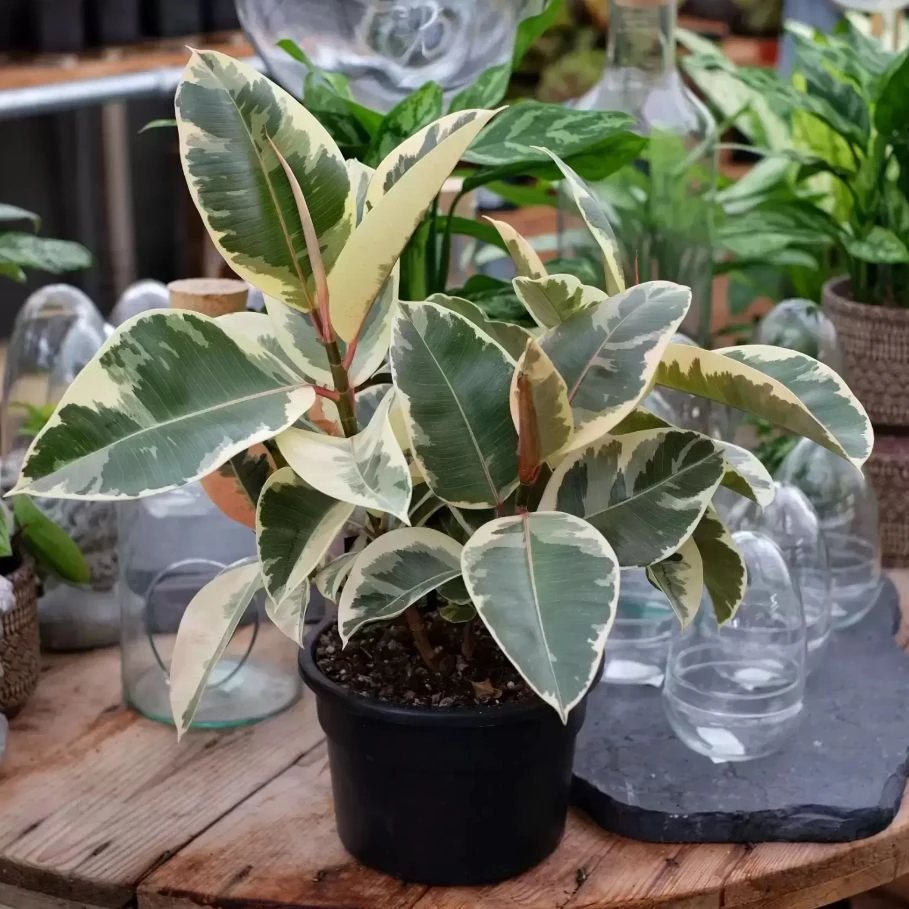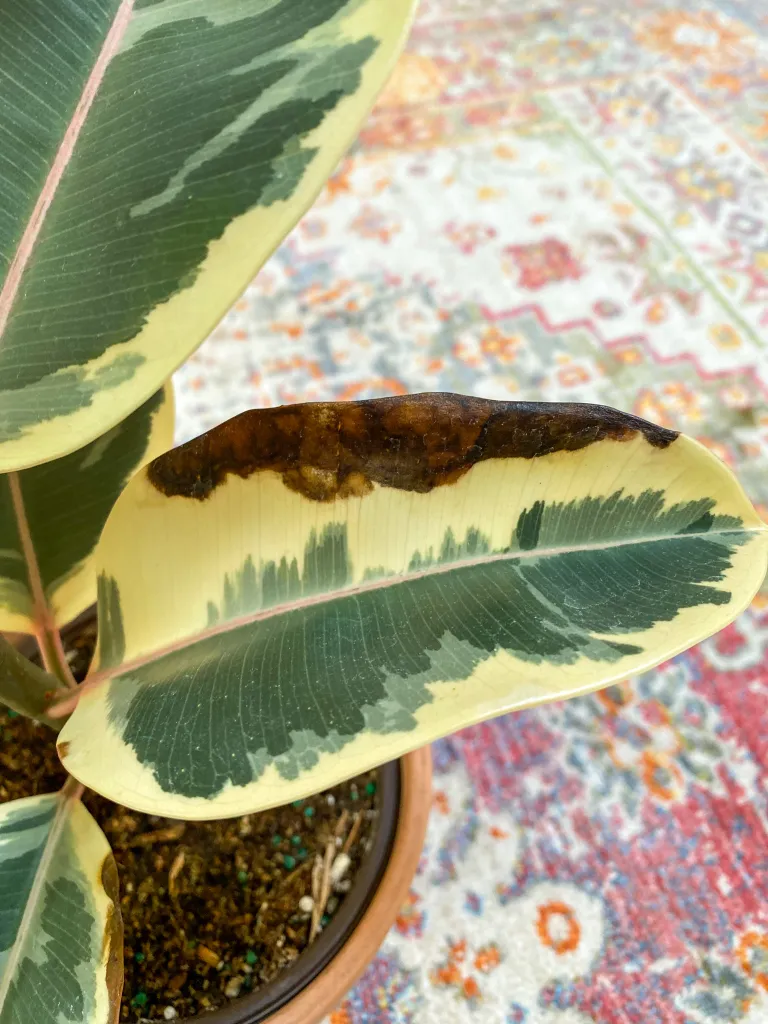Ficus Elastica Tineke is a rubber plant but it has an army camouflage look. This is a tropical houseplant you can grow easily at home. This popular plant has oversized oval leaves in glossy green color. It will be a nice ornament inside a bright and warm room.
Though Ficus Tineke is a colorful houseplant, you are allowed to grow this plant outside, if your environment remains humid and warm throughout the year. However, you want to watch the growth of this plant since it can grow rapidly outside.
How to Care for Ficus Elastica Tineke
As long as you can offer the right light to the plant, your Ficus Tineke can grow easily with low maintenance. It makes the plant ideal for those who are still new to houseplant enthusiasts. Simply dusting the leaves down and rotating the pot every couple of weeks will help the plant grow impressively.
What else can you do to keep the Ficus Elastica Tineke growing beautifully? Some guide below is going to help you get the most beautiful Ficus Tineke.
1. Light
This rubber plant loves the type of indirect but bright light that mimics its natural habitat, the tropical forest. You must balance in lighting to maintain the unique plant. This isn’t easy, if you give too much direct light, the foliage will be scorched.
And if you provide low-light conditions, the leaves will get pink hues. The natural and original color of the leaves will fade. Low light will also limit the growth of new leaves. This will make your plant look ugly with its unattractive legs. Place your Ficus Elastica Tineke in an east-facing window.
Or you can also set the plant back from the west or south-facing window. This plant will appreciate a couple of hours of soft sunlight in the morning. But don’t place the plant in direct afternoon rays.
Also read: Dracaena Lemon Lime
2. Soil
Ficus Tineke will appreciate any potting mix you have. But you may want to give it the best potting mix, prepare well-drained and loose potting mix to make your Ficus Tineke happy. Many Ficus Tineke plants can grow in slightly acidic cactus mixes.
Prepare well-aerated and well-draining Ficus Elastica Tineke soil. Any type of soil will be fine as long as it drains well. You are highly recommended to use a potting mix that has organic components. You are allowed to use garden soil, but less than 50% of your potting mix.
3. Watering
There is no need to spend too much time watering your Ficus Elastica Tineke. Plant your Ficus Tineke every week or once every two weeks, especially during its growing season. However, you need to consider the humidity and light around the plant before watering it.
One crucial thing about Ficus Elastica Tineke watering you should know is this plant loves consistent light moisture. But it doesn’t mean it will tolerate excessive dryness. You shouldn’t leave the plant in standing water since it will cause root rot. Slight underwatering is always better than overwatering.
Deep watering will also work well. When deep watering the plant, you shouldn’t drop the water on the leaves. Those drips will cause staining on the leaves.
4. Humidity and Temperature
All tropical plants, including this rubber plant, will appreciate moderate humidity and warm temperatures. The most ideal temperatures are between 60 and 75 degrees Fahrenheit. If the regular temperatures in your house are lower than 55 degrees Fahrenheit, avoid growing this plant.
This plant is also the worst choice if you often experience sudden temperature drops. When you finally bring the plant home and grow it successfully, place the plant away from dry heat, draughts, and AC units. This way, you’ll keep the plant growing healthily and happily.
5. Fertilizer
If you want to see large and glossy leaves on Ficus Elastica Tineke, the plant will need liquid fertilizer for a houseplant. Fertilize your plant every several weeks through the plant’s growing season. Avoid fertilizer that is too strong since this will make your plant grow straggly.
Strong fertilizer will also make your plant rootbound faster. There is no need to feed this rubber plant during the colder months.
6. Pruning
Ficus Tineke is a fast-growing tropical plant. This plant will benefit from tidying up. Prune the plant occasionally to keep the shape neat, encourage the growth of healthy and new foliage, and minimize the leggy growth. Trim off the unhealthy-looking leaves and straggly stems.
You can also remove healthy stems to create more beautiful and even shape and to propagate some new plants.
Also read: Plants That Like Full Sun and Heat
Ficus Elastica Tineke Common Problems
Rubber plants will grow very easily. But Ficus Tineke isn’t a magical plant that makes it free from problems. Some problems can attack your plant if it suffers from inappropriate conditions or neglect. What should you do when your beloved plant faces some problems?
Also read: Plants That Don’t Need Water
1. Yellow Leaves
When the leaves of your plant start turning yellow, the plant is telling you that it is taking too much water. Leaves turning yellow is also a sign that you place your Ficus Tineke in a too draughty position. Before rewatering the plant, you must check the soil.
If a couple of inches on the top of the soil feels moist, don’t water the plant. Wait a couple of days, check again, and then water the soil when the soil top isn’t moist anymore.
2. Leaves Falling Off
Premature leaf drop on your Ficus Tineke may be caused by underwatering. But it doesn’t mean that all cases of leaf loss are dangerous. Some cases of leaf loss are natural. As the plant grows, the lower leaves of the plant are going to drop off. This is how the plant focuses energy on the new growth.
Don’t let your Ficus Tineke get too dry, this is going to kill off the plant. The premature leaf drop can be a sign that you must fix your watering schedule. Don’t let your plant’s potting mix completely dry out in between the watering schedule.
Learn everything about how to care for Ficus Elastica Tineke. By practicing everything you have learned, your gorgeous Ficus Tineke will grow happily. Provide an ideal environment for the tropical plant.

